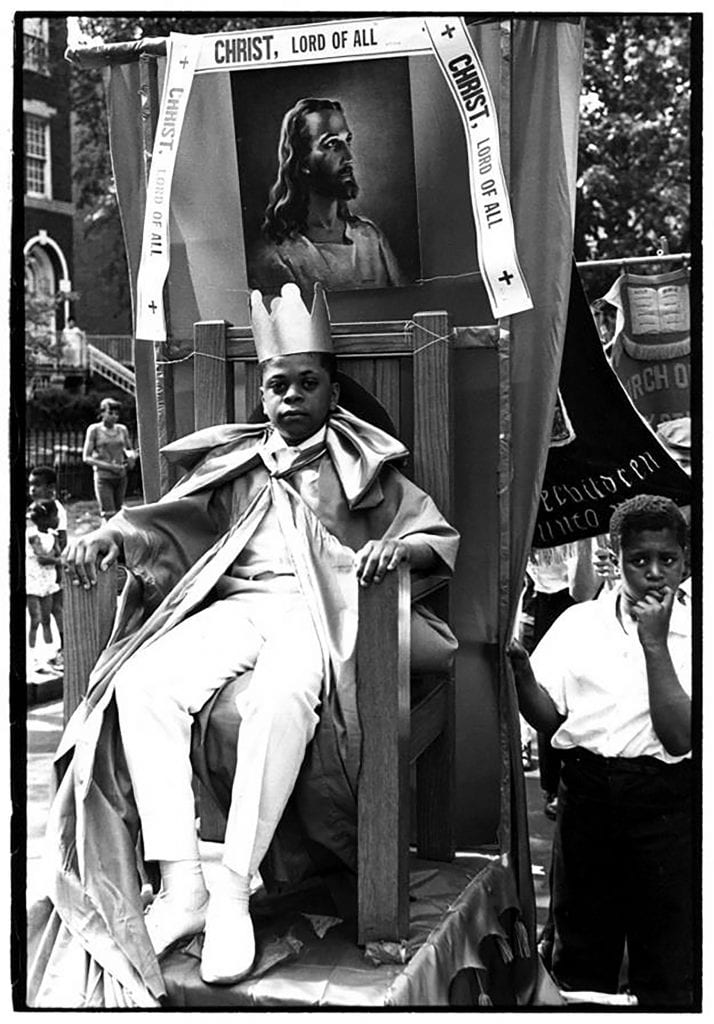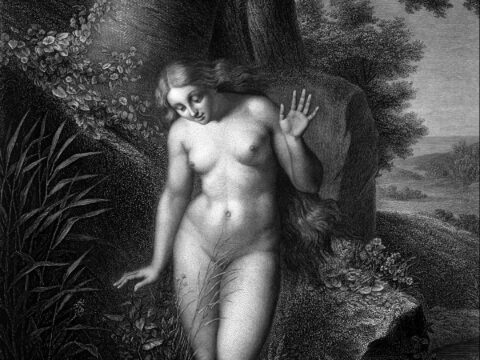As a young girl, I loved flipping through children’s illustrated Bibles. I’d often accompany my grandmother and aunt to the Christian bookstore, where they’d peruse the aisles, picking up materials for Sunday school lessons and other church activities. I was always happy to pass that time in the kids’ section with Bible characters coming alive on the page.
Following one such sojourn, we visited an older lady from church on the way home. Looking around her living room, I noticed a painting and asked who the subject was. The lady told me that it was Jesus. Later, as we headed back to the car, I turned to my grandmother and asked in bewilderment, “Why was her Jesus white?”
You may unsubscribe from any of our newsletters at any time.
As an African American millennial who grew up in the Baptist church, I always believed that Jesus was Black. I grew up surrounded by people who believed the same; in fact, nearly every African American Christian I have met shares this belief.
In my household, all of the depictions of Jesus centred around a Saviour whose skin was the colour of mine. My favourite piece of art in our home was a large painting of a Black Jesus benevolently watching us from above the fireplace, his tight, jet-black curls falling softly on his shoulders. But it wasn’t until I was an adult that I came to understand the long path tread by many to bring that framed image of Black Jesus to our home.
More on Broadview…
- How Jesus became white — and why it’s time to cancel that
- Years of living in a small town nearly ‘white-washed’ me. Then BLM came along.
- How therapeutic clowning injects humour for a different kind of healing
In 1924, Warner Sallman of Chicago sketched a portrait of Jesus for a magazine cover. The dean of Sallman’s Bible college, who inspired the sketch, opined that the existing images of Jesus were too effeminate. He suggested that Sallman’s rendering should portray a more manly Christ. Though the masculinity of his features were at issue, it’s no surprise that Jesus would be depicted as white; colonization constructed a society in which the white majority would not abide a Saviour of any other race. Sallman’s drawing, entitled the Head of Christ, went on to become the most reproduced image of Jesus. It is estimated to have been duplicated over half a billion times — including in my great-grandmother’s Bible.
I can recall flipping through her Bible years after her death. Pages full of birthdates and death dates, the history of our family, were carefully etched out in her handwriting. When I reached the middle of the Bible, a series of images appeared and Sallman’s Jesus stood out immediately.
What did imagery of a white Jesus mean for African American Christians? What did it mean for my great-grandmother, who was the daughter of an enslaved woman, Black, female and poor in the segregated South, toiling under the brutal system of sharecropping and fighting for survival? I can imagine it must have been very difficult to see those drawings candidly showcased in the middle of the Word that she so believed in. For her, Sallman’s portrayal would look less like the son of God, and more like the sheeted mob who burned down her barn and murdered her cow for daring to attempt to purchase land as a Black person. How could Sallman’s Jesus be reconciled as Saviour to those being terrorized under the harsh, unrelenting regimes of the Black Codes and Jim Crow laws?
The publisher listed on my great-grandmother’s Bible is the now-defunct World Publishing Company. At one time, it printed more Bibles than any other publisher in America. This Bible, containing Sallman’s Eurocentric rendering of the living Christ, represented the only type of Bible that she, and everyone else, would have been able to access during that era. People couldn’t find Bibles with imagery of a Black Jesus in the 1940s.

“I do recall images in perhaps all of our Black churches of this European Jesus,” states Rev. Nilous Avery, pastor of the historic Mount Zion Baptist Church in Salisbury, N.C. (and related to me). “Some of the members of the Black community did not want to make any waves and cause life to be more uncomfortable, because they were afraid of the powers that be.” African American demand for imagery of a Black Jesus could lead to backlash, he says, so Black churches and their members adopted the mainstream imagery as an act of self-preservation.
Sallman’s Jesus is a depiction grounded not in historical accuracy or research, but in the foundation of colonialism and white supremacy. This lens, rooted in the dogma that “white is right,” does not allow any alternative for the physical depiction of Christ, as it rigidly advances the status quo of the western world and promotes ideas of white superiority. Manifest destiny also warrants a mention here. The belief that God called white men to conquer and rule the entire world needed a Jesus that physically embodied the traits desirable to that particular group: white, blond and blue-eyed.
Malcolm X famously proclaimed Christianity to be a “white man’s religion,” advising African Americans that “the white man has brainwashed us black people to fasten our gaze upon a blond-haired, blue-eyed Jesus! We’re worshipping a Jesus that doesn’t even look like us!…The white man has taught us to shout and sing and pray until we die, to wait until death, for some dreamy heaven-in-the-hereafter, when we’re dead, while this white man has his milk and honey in the streets paved with golden dollars right here on this earth.”
As race relations in the South rose to a breaking point, and the beginnings of the civil rights movement took shape, Black theologians recognized the increased need to unequivocally relate the Gospel, both spiritually and historically, to the African American experience. Though Black preachers had long relayed sermons rooted in hope and healing on southern plantations throughout slavery, on through the unmitigated violence perpetrated against Blacks during the post-Reconstruction era, this emerging civil rights period represented an opportunity to outwardly and deliberately combat the white-supremacist version of Christianity while boldly empowering Black churches.
In 1966, Black liberation theology emerged with founder James H. Cone at its helm. This school of thought called upon Black people to fiercely love themselves despite living in a hostile country that showed no love in return. “For me,” writes Cone in Black Theology and Black Power, “the burning theological question was, how can I reconcile Christianity and Black Power, Martin Luther King, Jr.’s idea of nonviolence and Malcolm X’s ‘by any means necessary’ philosophy?”
Black liberation theology provided a reinterpretation of Christianity with Black empowerment at its centre. Free from the suffocating gaze of white supremacy, it offered African Americans self-affirmation, provided cultural relevance and focused on Christ as the liberator of the oppressed. As Avery of Mount Zion church remembers, liberation theology “caused sort of a shift….There began to be an identity of people who wanted to know more about their Blackness.”
This shift ushered in a change in the Black church, as Black people became more intentional about decolonizing their spaces and increasingly eschewed Eurocentric representations of Jesus the Christ. Though African Americans had always been active participants in their own battles for freedom and equality (through the Underground Railroad, Black contributions leading to the defeat of the Confederacy during the Civil War, the Great Migration and countless individual acts of resistance that may forever be lost to history), the revolutionary period of the 1960s buoyed acts of expression that were bolder than ever before. One need only recall a famous 1968 James Brown song for an example: “Say it loud — I’m Black and I’m proud!”
A colleague of mine possesses a vast collection of vintage fans garnered from Black churches and funeral homes. Hundreds of fans, hailing from all over the South, line her walls in a glorious display of tradition. Looking at them, I immediately notice a marked difference. Most of the 1960s fans prominently feature King, but starting in the 1970s, they begin to depict the previously elusive Black Jesus. As Avery summarizes: “Over a period of time, this Blackness of the Bible became acceptable, and it became realistic when people decided to do their theological study, their historical study, and marry the two.”
In 2018, the Pew Research Center published a study that found roughly eight in 10 African Americans identify as Christian, and most are associated with historically Black Protestant churches. Black Americans are more likely than the general public to be Christian and to read scripture at home. Today, we can easily find depictions of a Black Jesus in many Bibles. As I pick up my own Bible, I can’t help but think of how pleased my great-grandmother would be to see the rendering of a Black Christ throughout.
***
J. Nailah Avery is a trained lawyer and Black history scholar currently working in technology. She is based in Raleigh, N.C.
This story was first published in Broadview’s April/May 2021 issue with the title “A Portrait of Liberation.” It was updated on March 24, 2021 to reflect that Rev. Nilous Avery is, in fact, related to the author.















If we lived in China, India or Iran this would be a mute issue.
Did I not once hear “We preach Christ!!”?
I don’t think it mattered what colour Christ was to your great-grandmother. She had the belief that Christ was God, died, rose again on the third day, ascended into heaven and is returning to gather His followers in the (near?) future.
Christ isn’t an experience, He’s a way of life. Please put away your biases against my ancestors’ biases, Christ doesn’t promote it, so why should you? God is not racial, neither did I see God as racial until BLM appeared.
Let’s not forget, God created all of us differently, (or you would be perfect as I am), and each member is used by God through the Holy Spirit to fulfill different roles within the Body of Christ. For this I am truly thankful that my black, Asian and Middle Eastern brother and sisters worship in my congregation, and we don’t hold grudges about the past that we can’t change. We look to the future when we will worship God together in Heaven.
This article would have been more appropriately placed under the opinion column. Its got nothing to do with spirituality. The title this magazine chose to focus on was the one line statement by the author who said and I paraphrase White Jesus colonial (read bad) and black Jesus the real deal. Thats an opinion. It would be like me writing an opinion piece that stated that critical race theory is the most racist ideology ever invented by the progressive left. The difference being I might take some time to explain why I thought progressive Christianity has little to say about Jesus except to caste him in their own image.
Blue-eyed, fair-skinned settlers inhabited the Levant some 6,500 years ago, according to an international interdisciplinary team of scientists. https://www.timesofisrael.com/anomalous-blue-eyed-people-came-to-israel-6500-years-ago-from-iran-dna-shows/
The “Letter of Lentulus,” is an alleged eyewitness account of Jesus Christ, it describes Jesus Christ’s face as being a comely red and his eyes gray, clear and quick.” https://commons.orthodoxwiki.org/images/c/cf/Anon-Publius_Lentulus.jpg
Certainly, a Palestinian Jewish child would never be snow white or bleached nor black.
Thanks to the Italian artists who made angels and Jesus milky white and anemic!
It is obtuse that in 2021 we discuss the skin color of Jesus – not his life and teachings! Were Moses, Mahavira, Mohammed, Gautama, Krishna, Nanak, etc. were also unpigmented? Maybe medieval Italian artists never heard of those men.
If we look at scripture we see that the Lord Jesus Christ and the Israelite peoples of the bible are described as being White in appearance. e.g. KING DAVID is described as “RUDDY” in 1 Samuel 16:12, and 1 Samuel 17:42.
1 Samuel 16:12 https://www.biblegateway.com/passage/?search=1+Samuel+16%3A12&version=KJV
1 Samuel 17:42 https://www.biblegateway.com/passage/?search=1+Samuel+17%3A42&version=KJV
The Lord Jesus Christ is a descendant of King David, via his mother the Blessed Virgin Mary, who was of the lineage of David (Psalm 132:11; Luke 1:32).
Psalm 132:11 https://www.biblegateway.com/passage/?search=Psalm+132%3A11&version=KJV
Luke 1:32 https://www.biblegateway.com/passage/?search=Luke+1%3A32&version=KJV
Ruddy: adjective. (of a person’s face) having a healthy red colour: https://www.lexico.com/definition/ruddy
The ISRAELITES are described as “WHITE” and “RUDDY” in Song of Solomon 5:10 “My beloved is WHITE and RUDDY, the chiefest among ten thousand.”
Song of Solomon 5:10 https://www.biblegateway.com/passage/?search=Song+of+Solomon+5%3A10&version=KJV
In Revelation 1:14, JESUS CHRIST is described as having a HEAD that is “WHITE AS SNOW” (Head includes face).
Revelation 1:14 https://www.biblegateway.com/passage/?search=Revelation+1%3A14&version=KJV
The Nazarites are described as being “purer than snow, WHITER THAN MILK,” in Lamentations 4:7. (Nazarites = ISRAELITES, Numbers 6:2)
Lamentations 4:7 https://www.biblegateway.com/passage/?search=Lamentations+4%3A7&version=KJV
Numbers 6:2 https://www.biblegateway.com/passage/?search=Numbers+6%3A2&version=NKJV
The reality is that most ethnicities/races inhabiting North Africa and the Middle East today, are not the same ethnicities/races that inhabited North Africa, Palestine, around the time of Jesus Christ, the days of Moses, etc.
70 percent of British men and 50% of Western European men belong to the genetic profile group known as haplogroup R1b1a2, which Egyptian Pharaoh Tutankhamun, belonged to according to geneticists at Zurich-based DNA genealogy centre, iGENEA. Among modern-day Egyptians this haplogroup contingent (R1b1a2) is below 1 percent. https://uk.reuters.com/article/oukoe-uk-britain-tutankhamun-dna/half-of-european-men-share-king-tuts-dna-idUKTRE7704OR20110801
Scientists who managed to obtain full genome sequences of Ancient Egyptians for the first time have concluded the people of the pharaohs were more closely related to modern Europeans and inhabitants of the Near East rather than present-day Egyptians. https://www.independent.co.uk/news/science/archaeology/ancient-egyptians-europeans-related-claims-a7763866.html
Coffin of Tutankhamun’s great-grandmother opened to show preserved body with blonde hair. https://www.dailystar.co.uk/news/world-news/tutankhamun-great-grandmother-coffin-ancient-17215576
Blue-eyed, fair-skinned settlers inhabited the Levant some 6,500 years ago, according to an international interdisciplinary team of scientists. https://www.timesofisrael.com/anomalous-blue-eyed-people-came-to-israel-6500-years-ago-from-iran-dna-shows/
The article titled “The only Jewish male hair ever found” discusses DNA tests that were conducted on ancient Israelite skeletons, dated to the 1st century BC, found in stone ossuaries next to the tomb of Annas, the high priest, father in law of Caiaphas, the high priest who betrayed Jesus Christ to the Romans. Hence it is thought that this shrouded man was either a priest or a member of the aristocracy. One of the more fascinating finds in this tomb, was the preservation of a sample of Jewish male hair. The length of the hair was medium to short, averaging 3-4 inches. The color was REDDISH. [Red hair is most commonly found among people of white European heritage, it’s rare for non-whites to have red hair]. https://www.biblicalarchaeology.org/daily/ancient-cultures/ancient-israel/the-only-ancient-jewish-hair-ever-found/
I know historically Jesus the Messiah was neither European nor African. His human ancestry was of the Israeli descent. Olive skinned peoples. I also do not care what He looked like. It is His Character, His Love, His Justice and His Sacrifice for me I care about.